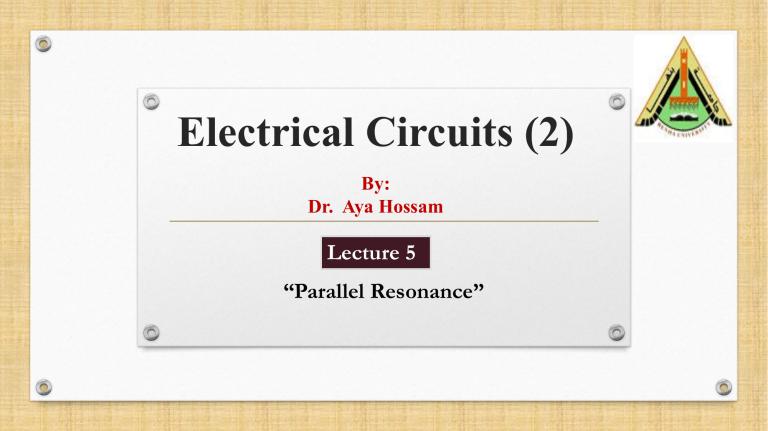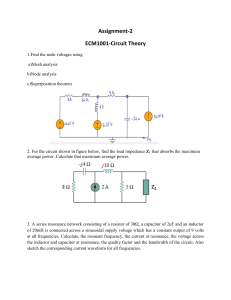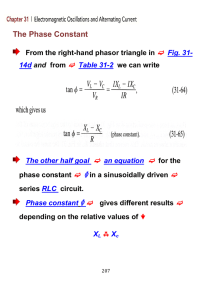
Electrical Circuits (2) By: Dr. Aya Hossam Lecture 5 “Parallel Resonance” Remember Series Resonance Parallel Resonance Circuit It is usually called tank circuit Practical Circuits Ideal Circuits Complex Configuration RL RC v(t) L C Ideal Parallel Resonance Circuit The total admittance Y = Y1 + Y2 + Y3 1 1 1 Y= + + R (j.L) (-j/.C) 1 -j Y= + + jωC R ωL 1 Y= + j(ωC − 1/ωL) R Ideal Parallel Resonance Circuit At parallel resonance: ✓ At resonance: the admittance consists only conductance G = 1/R. ✓ The value of current will be minimum since the total admittance is minimum. ✓ The voltage and current are in phase. ✓ The inductor reactance and capacitor reactance canceled, resulting in a circuit voltage simply determined by Ohm’s law as: ✓ The frequency response of the impedance of the parallel circuit is shown exactly opposite to that in series resonant circuits, Ideal Parallel Resonance Circuit The Q of the parallel circuit is determined from the definition as: For Currents: Reciprocal of series case ✓ The currents through the inductor and the capacitor have the same magnitudes but are 180 out of phase. ✓ Notice that the magnitude of current in the reactive elements at resonance is Q times greater than the applied source current. Ideal Parallel Resonance Circuit ➢ Parallel resonant circuit has same parameters as the series resonant circuit. 1 ω = rad/s Resonance frequency: p LC Half-power frequencies: Bandwidth and Q-factor: Summary law’s of Ideal parallel resonance Circuit 1 rad/s LC 1 1 Y= = + j(ωC − 1/ωL) Zt R ωp = Ideal Circuits Frequency Response Curve Examples Example (1) Consider the circuit shown in Figure a. Determine the resonant frequencies, ωP(rad/s) and fP(Hz) of the tank circuit. b. Find the Q of the circuit at resonance. c. Calculate the voltage across the circuit at resonance. d. Solve for currents through the inductor and the resistor at resonance. e. Determine the bandwidth of the circuit in both radians per second and hertz. f. Sketch the voltage response of the circuit, showing the voltage at the half-power frequencies. g. Sketch the selectivity curve of the circuit showing P(watts) versus ω(rad/s). Solution Solution




